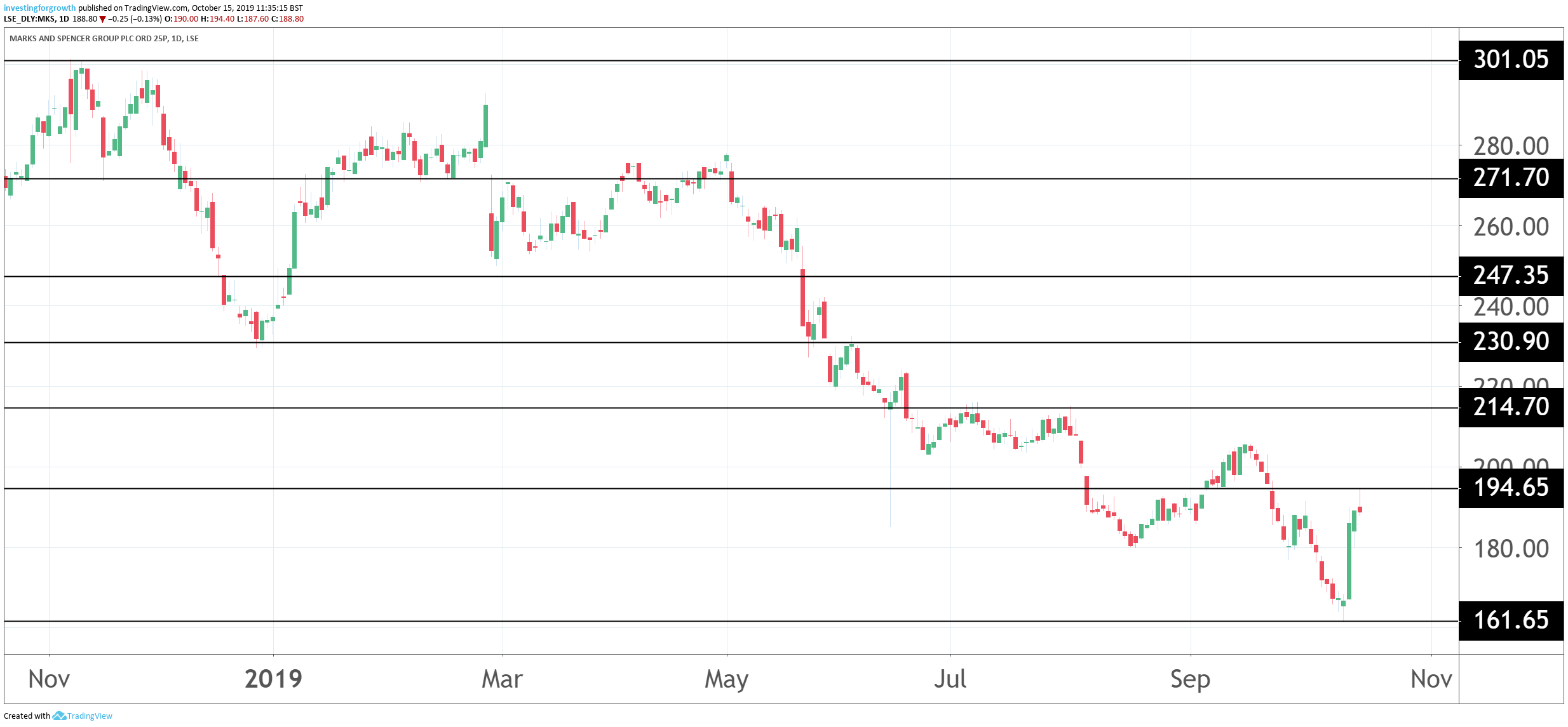Stockwatch: A fallen blue-chip for your Brexit portfolio
Our companies analyst spots a potentially useful addition to the known basket of "Brexit deal" stocks.
15th October 2019 11:23
by Edmond Jackson from interactive investor
Our companies analyst spots a potentially useful addition to the known basket of "Brexit deal" stocks.

Banks, housebuilders and REITS got most attention in Friday's circa 10% re-rating of UK domestic equities, but a standout share was Marks & Spencer (LSE:MKS), up 12%from 166p to 186p, edging higher to 192p this week.
Currently at around 188p, you might ask how is M&S a beneficiary of any Brexit deal, and could this conflate usefully with the stock having recently hit a four-year low? Might a 1st October investor day with the slogan "Far Reaching Change at M&S" hint at longer-term recovery potential? Or is this more likely a dead-cat bounce amid desperate discounting on the high street currently?
'Buy' modestly-rated UK domestic equities
Whatever the long-term uncertainties, an increased willingness this week, both from the EU and British MP's to agree a Brexit deal, means UK domestic stocks will continue to rally in the very near term. This is part-due to downwards pressure on sterling being lifted, hence "UK assets" shares rising – which arguably should include retailers with a substantial property base, being de-risked.
Not to get carried away though: retail property still has long-term operational risks. Lifting Brexit uncertainty – at least by way of confirming a Withdrawal Agreement – won't be unhelpful to consumer confidence. So, consider buying retailers besides REITS, housebuilders and banks already in the frame.
M&S's equity profile shows the kind that's now sensitive to good news on Brexit: despite cutting the dividend from 17.9p a share in recent years, with a current consensus for 10.9p based on 1.7x projected earnings cover, this equates to a reasonably supportive 6% yield. The prospective price/earnings (PE) ratio of around 10 times assumes the earnings per share (EPS) consensus of about 19p in both the 2020 and 2021 financial years.
Net tangible assets per share as of last March were about 112p, although, as Greene King's (LSE:GNK) takeover showed, property professionals may know how to sweat out premium values to the accounts.

Source: TradingView Past performance is not a guide to future performance
Yesterday, Goldman Sachs reiterated its "base case" scenario that the UK will indeed leave the EU by 31 October with a close variant of the Withdrawal Agreement negotiated previously. According to events being reported this morning, this does appear a working assumption now likely to gain support. The EU and British MP's alike are so weary of the Brexit process that an extra effort with compromises on both sides is looking likely, to get a WA over the line, potentially even for voting in Saturday's UK parliamentary debate.
Goldman's financial rationale appears significantly related to currency, mooting that each 1% upward move in sterling translates likewise into a 1% outperformance by UK domestic equities versus the FTSE 100 index. They estimate sterling's exchange rate to rise to about $1.30 versus $1.26 currently, although I imagine realistic news of a deal would trigger stock speculation also – so 5-10% upside is possible before reality sets in, a WA being only one step of the way to Brexit. It would still mark a huge sigh of relief.
Much remains to be done, for an M&S transformation
In a marketing sense, M&S is essentially a mid-tier retailer possibly comparable to Sainsbury's (LSE:SBRY) in terms of food – i.e. exposed to continued encroachment by Aldi/Lidl as they expand UK stores and take share, often discounting essential items more cheaply if people can tolerate a fairly standardised and limited range of produce.
M&S's legacy development as urban department stores, often tagging a food hall into rear space, makes it typically more suited to top-up buying than "the weekly shop" where people drive to and park at a dedicated supermarket venue. This explains a radical move last May to buy 50% of the UK retail business of Ocado Group (LSE:OCDO) for £750 million, enabling M&S to promote and distribute its products on Ocado's platform from 2020.
It could also be seen a vote of confidence by Ocado in shifting its alliance from Waitrose; however, there's a way to go given that Ocado had just a 1.4% share of the UK grocery market at end-August, despite the fastest-growing revenues at 12.6% annually. The Big 4 are all losing sales/share while Aldi and Lidl are up 7.7% and 6.2% respectively. Such extent of capacity means overall sales are pretty flat: August saw M&S and Sainsbury's grow sales by 1.4% and 1.3% respectively.
| Marks & Spencer Group | ||||||||
|---|---|---|---|---|---|---|---|---|
| year end 30 Mar | 2014 | 2015 | 2016 | 2017 | 2018 | 2019 | ||
| Turnover (£ million) | 10,310 | 10,311 | 10,555 | 10,622 | 10,698 | 10,377 | ||
| Operating margin (%) | 6.7 | 6.8 | 5.5 | 2.4 | 1.5 | 1.6 | ||
| Operating profit (£m) | 695 | 701 | 584 | 253 | 157 | 162 | ||
| Net profit (£m) | 525 | 487 | 407 | 117 | 25.7 | 33.5 | ||
| IFRS3 earnings/share (p) | 30.8 | 28.3 | 23.7 | 6.9 | 1.5 | 2.0 | ||
| Normalised earnings/share (p) | 34.5 | 32.2 | 37.4 | 36.1 | 36.8 | 31.2 | ||
| Operating cashflow/share (p) | 66.3 | 74.2 | 70.6 | 62.6 | 49.9 | 55.0 | ||
| Capex/share (p) | 37.7 | 40.6 | 32.0 | 24.1 | 20.5 | 18.4 | ||
| Free cashflow/share (p) | 28.6 | 33.6 | 38.5 | 38.6 | 29.4 | 36.6 | ||
| Dividend/share (p) | 16.3 | 17.2 | 17.9 | 17.9 | 17.9 | 13.3 | ||
| Covered by earnings (x) | 1.9 | 1.6 | 1.3 | 0.4 | 0.1 | 0.2 | ||
| Net Debt (£m) | 1,904 | 1,808 | 1,806 | 1,747 | 1,575 | 1,365 | ||
| Net assets per share (p) | 159 | 186 | 203 | 186 | 174 | 158 | ||
| Source: historic Company REFS and company accounts | ||||||||
Clothing is well marked out as a dicey sector of discretionary spending - especially among high street retailers versus online specialists – and where M&S has had to overcome a rather tired image. In fairness, the 1 October investor day "Far Reaching Change at M&S" (presentation is downloadable from M&S's corporate website) cited a host of initiatives including "restore style, fit and value" in clothing. The presentation continues to claim the No. 1 position in the UK's £35 billion clothing market, although in May 2018 it was being reported that M&S had been losing share for more than two decades and Primark had been on a rising trend – its 7% share is set to overtake M&S's 7.6%.
Key operational details within the annual results to 30 March 2019 showed modestly falling revenue, both in food and clothing, and in operating profit both at home and abroad, despite some progress on margins. At group level the numbers were mixed for profitability and EPS, as if potentially the tanker could be turning.
In food, excuses were: "price investment" i.e. cutting, in a saturated industry for supermarket sales; a change in product mix as promotions were cut back; also, an element of net store closures despite some openings in the highest-returning locations. Similarly, in clothing and home items, store closures were blamed for a 3.6% revenue decline, although online revenues rose an encouraging 9.8%.
Such a UK retailing context makes it very difficult for M&S to deliver positive surprises when it announces interim results on 6 November. Buying its shares now is essentially part of a "risk-on" trade for UK domestic equities, where M&S holders would get a reality check by way of six months' performance to end-September, and potentially some caution about the current environment, given plenty of aggressive discounting on the high street right now.
One choice in a basket of domestic UK stocks
Yet I think that mitigating uncertainty over Brexit, by way of an agreement proceeding to a trade deal, and Boris Johnson potentially restoring a Conservative majority government versus a radical left-wing Labour alternative, is likely to see "domestic UK" equities trading higher than today – almost irrespective of companies' near-term numbers and narratives.
So, while the market has already underlined banks, housebuilders, REITS, indeed much of the domestic Mid 250 index, as a 'trading buy' on finalising a Brexit WA, M&S could also continue to party in the weeks ahead, if confidence grows that a deal can be wrested.
There isn't particularly active short-interest: disclosed stock on loan is around 4.9% having fallen from 10-12% during mid-2017 to end-2018, and no new positions have recently been taken. During October so far, two of four hedge funds disclosed as short-sellers have reduced their exposure. This pattern suggests short-sellers view M&S shares as fairly priced after de-rating from 300p nearly a year ago.
Currently, share price movements in M&S continue in similar vein as high-profile WA agreement plays such as Lloyds Bank (LLOY) and Barratt Developments (BDEV). The contrarian inside me is intrigued not to overlook M&S, as a potential sub-sector re-rating looks underway.
Overall it looks wise to consider a basket of such stocks, and possibly also REITS and domestic Mid 250 stocks. For M&S: Buy.
Edmond Jackson is a freelance contributor and not a direct employee of interactive investor.
These articles are provided for information purposes only. Occasionally, an opinion about whether to buy or sell a specific investment may be provided by third parties. The content is not intended to be a personal recommendation to buy or sell any financial instrument or product, or to adopt any investment strategy as it is not provided based on an assessment of your investing knowledge and experience, your financial situation or your investment objectives. The value of your investments, and the income derived from them, may go down as well as up. You may not get back all the money that you invest. The investments referred to in this article may not be suitable for all investors, and if in doubt, an investor should seek advice from a qualified investment adviser.
Full performance can be found on the company or index summary page on the interactive investor website. Simply click on the company's or index name highlighted in the article.
Disclosure
We use a combination of fundamental and technical analysis in forming our view as to the valuation and prospects of an investment. Where relevant we have set out those particular matters we think are important in the above article, but further detail can be found here.
Please note that our article on this investment should not be considered to be a regular publication.
Details of all recommendations issued by ii during the previous 12-month period can be found here.
ii adheres to a strict code of conduct. Contributors may hold shares or have other interests in companies included in these portfolios, which could create a conflict of interests. Contributors intending to write about any financial instruments in which they have an interest are required to disclose such interest to ii and in the article itself. ii will at all times consider whether such interest impairs the objectivity of the recommendation.
In addition, individuals involved in the production of investment articles are subject to a personal account dealing restriction, which prevents them from placing a transaction in the specified instrument(s) for a period before and for five working days after such publication. This is to avoid personal interests conflicting with the interests of the recipients of those investment articles.